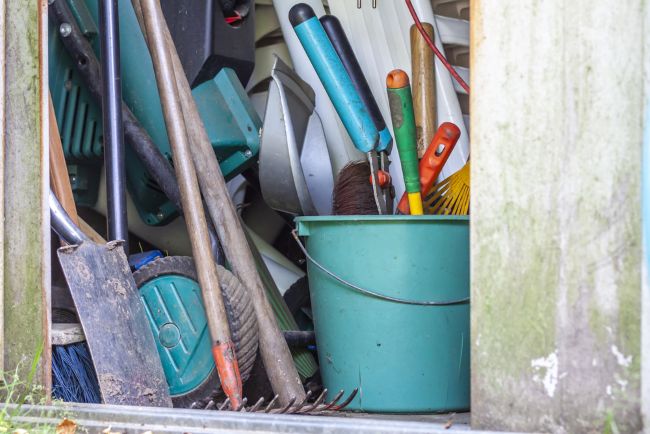How to Organise Your Garage for Gardening

A messy garage is often a gardener’s worst enemy. You might have the greenest thumb in the neighbourhood, but if you can’t find your favourite trowel or you’re constantly tripping over the lawnmower, your passion project can quickly become a source of frustration. An organised garage not only saves you time and stress but also helps protect your valuable tools from damage, ensuring they last for years to come.
This guide will walk you through everything you need to know about transforming your cluttered garage into a functional and efficient space for all your gardening equipment. We’ll cover how to sort through your items, choose the right storage solutions, and create a system that keeps everything tidy and accessible. By the end, you’ll have a clear plan to conquer the clutter and create a gardener’s paradise right in your own garage.
Get Started: Sort and Declutter
The first step in any organisation project is to figure out exactly what you have. It’s time to pull everything out of your garage and take a proper inventory. This might seem like a daunting task, but it’s essential for creating a space that truly works for you.
1. Empty the Space
Start by taking everything out of the garage. This gives you a blank canvas and allows you to see the full extent of the space you have to work with. As you remove items, group them into broad categories like gardening tools, car supplies, sports equipment, and miscellaneous. This initial sort will make the next step much easier.
2. Create Three Piles: Keep, Donate, and Bin
Now, go through each item and decide its fate. Be honest with yourself about what you truly need and use.
- Keep: These are the items you use regularly and are in good working condition. This pile will include your essential gardening tools, from secateurs and forks to your trusty lawnmower.
- Donate: Items that are still in good shape but you no longer use can find a new home. Think about duplicate tools, old pots, or equipment you’ve since upgraded. Local community gardens or charities might be grateful for them.
- Bin: Anything broken, rusted beyond repair, or simply useless should be thrown away. Check with your local council for guidelines on disposing of items like old chemicals, batteries, or large equipment.
3. Clean and Prepare the Space
With the garage empty, seize the opportunity to give it a thorough clean. Sweep the floors, wipe down surfaces, and clear away any cobwebs. A clean space is not only more pleasant to work in but also helps you spot any potential issues like dampness or pests.
Plan Your Perfect Garage Layout
Once you have a clear idea of what you’re keeping, you can start planning how to arrange it all. The key to a functional layout is to create dedicated zones for different activities and types of items. This makes it easier to find what you need and, more importantly, to put things back where they belong.
Zone Your Space
Think about how you use your garage. A common approach is to divide it into zones. For a gardener, you might want to create a specific “Gardening Corner.” This area should be located near the garage door for easy access to your garden. Other zones could include a workshop area for DIY projects, a storage space for seasonal items, and, of course, a spot for your car.
Sketch a Simple Plan
You don’t need to be an architect to create a useful layout. Grab a piece of paper and a pencil and sketch out a rough floor plan of your garage. Mark out the different zones and decide where your larger items, like the lawnmower and wheelbarrow, will live. This visual guide will help you make the most of your available space.
Smart Storage for Gardening Tools
Now for the fun part: choosing your storage solutions. With a well-thought-out plan, you can select the right products to keep your gardening tools organised, safe, and easily accessible.
Utilise Vertical Space
One of the most effective ways to maximise garage storage is to think vertically. Walls offer a huge amount of untapped potential for organising your tools.
- Pegboards: A classic for a reason, pegboards are incredibly versatile. With a variety of hooks, baskets, and shelves, you can create a customised storage system for your hand tools like trowels, forks, and gloves. Having them visible and within easy reach means you’ll never have to rummage through a messy drawer again.
- Wall-Mounted Racks: For larger tools like rakes, shovels, and brooms, wall-mounted racks are a fantastic solution. They keep long-handled tools off the floor, preventing them from becoming a trip hazard. Look for racks with adjustable hooks so you can adapt the spacing to fit your specific tools.
Choose the Right Shelving
Shelving is the backbone of any organised garage. When it comes to storing heavier items like bags of compost, large pots, and power tools, you need something sturdy and reliable.
- Freestanding Shelving Units: High-quality garage shelving units are a must. Opt for metal or heavy-duty plastic units that can withstand the weight of your gardening supplies. Adjustable shelves are a bonus, allowing you to customise the height to accommodate items of different sizes.
- Wall-Mounted Shelves: For lighter items or to create a dedicated potting station, wall-mounted shelves are a great option. Position a sturdy shelf above a workbench to keep your pots, seeds, and small tools organised while you work.
Store Small Items and Supplies
It’s often the small bits and pieces that create the most clutter. Seeds, plant labels, twine, and other small items can easily get lost if not stored correctly.
- Clear Containers: Use clear plastic bins or jars to store small supplies. The transparency allows you to see what’s inside at a glance, saving you from having to open multiple containers to find what you need. Label each container for even better organisation.
- Drawer Units: A small set of drawers can be perfect for organising seeds, gloves, and other small accessories. Sort items by type into different drawers to keep everything neat and tidy.
Set Up a Potting Bench
If you have the space, a dedicated potting bench can be a game-changer for any gardener. It provides a comfortable and organised workspace for all your planting tasks, from sowing seeds to repotting plants.
Your potting bench doesn’t have to be fancy. A simple, sturdy workbench will do the trick. Position it in your gardening zone, ideally with good lighting. Use the surface for your work and install shelves or a pegboard above it to keep your most-used tools within arm’s reach. You can also use the space underneath the bench for storing larger bags of soil and compost.
Maintain Your Organised Garage
Creating an organised garage is a great achievement, but the real challenge is keeping it that way. The key to long-term success is to build good habits and make tidying up a regular part of your routine.
- A Place for Everything: Stick to the golden rule of organisation: a place for everything, and everything in its place. After you finish gardening, take a few minutes to clean your tools and return them to their designated spots.
- Regular Tidy-Ups: Schedule a quick 15-minute tidy-up once a week. This will help you stay on top of any clutter before it gets out of control.
- Seasonal Reviews: At the end of each season, take some time to review your garage organisation. What’s working well? What isn’t? This is a good opportunity to adjust your system and declutter any items you no longer need.
Your Tidy Garage Awaits
Organising your garage for your gardening tools doesn’t have to be an overwhelming project. By breaking it down into manageable steps—sorting, planning, and implementing smart storage solutions—you can create a functional and inspiring space. A tidy garage will not only make your gardening tasks more enjoyable but also give you a sense of calm and control every time you step inside. So, roll up your sleeves and get ready to transform your clutter into order.


